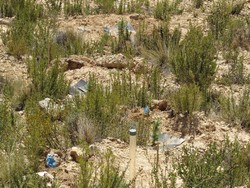Environment friendly soil conditioners and groundcovers restore forests
A significant number of the 100 million trees planted yearly in Europe die because of drought and competition from weeds. Current reforestation techniques to combat these threats rely heavily on the recurrent use of herbicides, water and fossil fuels, which come at a high economic and environmental cost. The aim of the EU-funded project SUSTAFFOR(opens in new window) (Bridging effectiveness and sustainability in afforestation / reforestation in a climate change context: new technologies for improving soil features and plant performance) was to conceive, produce, develop and thoroughly evaluate new technologies for reforestation projects. Project partners developed prototypes of soil conditioners, including water-absorbent polymers among other 22 ingredients to improving conditions at micro-site level. They also developed 4 prototypes of groundcovers with the intention of impeding weed establishment and reducing soil water evaporation near the tree. Of these mulches, 3 were 100 % biodegradable and composed of new biopolymers or woven jute fibres treated with bio-resin. The fourth mulch was made of recycled rubber thereby enabling its reuse in successive plantations. Rigorous field and laboratory tests were conducted before producing commercial prototypes for international marketing and sale. Results showed a 90 % tree survival rate, with 50 % growth increase in the early stages with respect to untreated trees. The new soil conditioner and the new biodegradable groundcovers are of particular use in sites located far from populated areas and/or in uneven land or steep slopes, where repeated application of traditional treatments are expensive to apply. They can also help minimise the use of machinery thereby minimising noise and protecting vulnerable soil and vegetation. Other positive environmental-social impacts of SUSTAFFOR include reducing considerably carbon emissions and harmful by-products currently produced by the use of herbicides, irrigation, mechanical weeding and petrol-based mulches. Hence the techniques developed by the consortium have been shown to outperform conventional methods when considering economic and environmental aspects together. In addition, all of them have areas of application where they are economically cheaper than conventional techniques. Therefore, a gap in the market exists where these approaches can be promoted.







